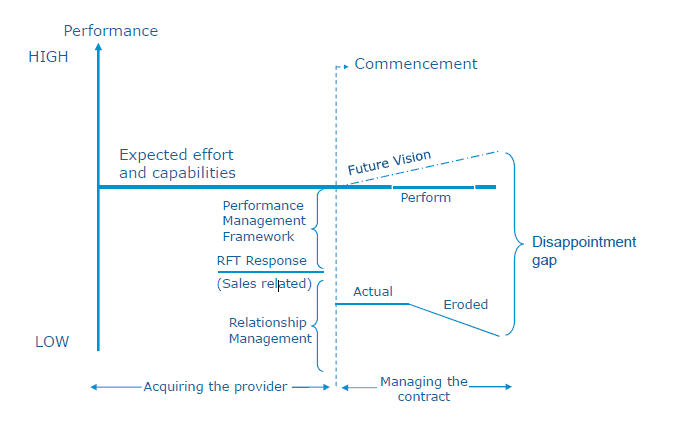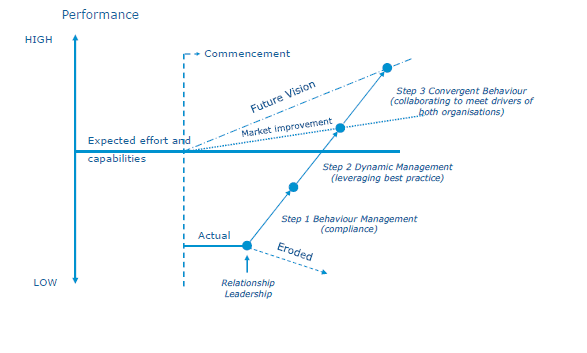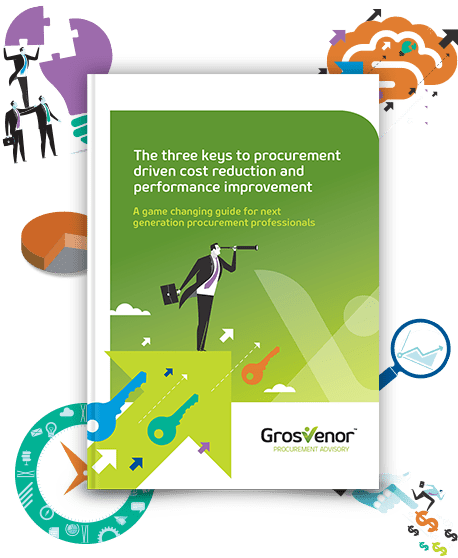Why contract performance always disappoints the buyer

A recurring theme for many procurement staff is the erosion over time of the actual performance of their service contracts. Why is it that, despite the increasing use of robust tools and templates and the increasing proficiency of procurement staff, purchasers continue to feel dissatisfied with their contracts?
Over time; price creep, scope pullback, service level failures, lack of innovation and increasing levels of distrust increasingly characterise their customers’ experiences.
We have coined the term the Disappointment Gap for this phenomenon.
The Disappointment Gap
In undertaking a tender, clients commit considerable resources to ensuring;
- their exact service needs are well specified, often representing significant intellectual property
- the necessary information is provided to tenderers
- they have an excellent understanding of what constitutes the ideal service provider
- all relevant risks are managed
Typically, sourcing departments and their customers have a future vision of continuous improvement over the course of the contract. This vision is often given effect by innovation-related KPIs and/or formal gainshare arrangements.
These expectations are built into contracts in the knowledge that the market’s capability will continue to improve through such things as technology and productivity improvements.
When RFT documents are released to the market, the evaluation teams’ expectations of the market’s ability to both respond insightfully and then deliver the contract, are high.
Tender responses are developed by business developers whose role it is to win contracts, not deliver them.
Many evaluators report their disappointment with the gap between the expectations set in the RFT and the responses received.
Further disappointment is frequently reported after contract commencement, as the client contract managers come to realise the promised performance of the service provider is not reflected in the actual delivery. Their experience can be further exacerbated by failure of both parties to achieve mutually beneficial contract management relationships.
The difference between the idealised future vision and the eroded actual performance is the Disappointment Gap.
This phenomenon is depicted in the diagram below:

Contract Congruence
The existence of this gap can be further understood by examining the key issues that get in the way of achieving goal congruence between client and provider. The
table below identifies these issues:
| CLIENT | SUPPLIER |
| Manages down costs | Seeks to build revenues |
| Seeks improved services | Aims to reduce costs |
| Documents and transfers IP | Learns and leverages IP |
| Manages risk (in part) regularly seeks reassurance by contract term | Aims to extend length of contract |
| Welcomes competitive market tension | Seeks market dominance |
| Desires strategic collaboration | Is (micro) managed on operational performance |
| Aims for contract mobility | Aims for client “stickiness” |
It is only by acknowledging and responding to these often competing issues that goal congruence will be improved and the Disappointment Gap minimised.
Experience has shown that it must be the client organisation which shows leadership in the contract relationships, if real change is to be achieved.
Bridging the Disappointment Gap
There are three steps to bridging the gap. They must be done sequentially, each of them takes time and they are increasingly difficult to achieve.
Step 1 Behaviour Management
There is a widely held view that a good contract (relationship) is one where the contract can be left in the bottom drawer. There are many reasons why this opinion is flawed. Here are two: the first is the need to establish trust. Service takers (business units, customers etc) must be able to trust that the tasks and associated service levels specified in the contract will be delivered as the provider’s proposal originally promised they would be.
Until such time as the service takers trust the provider with their business as usual needs, the prospects of their allowing the provider to innovate and improve; read modify, are effectively nil.
The second is the loss of intellectual property. It occurs as the client loses those in house staff who had the original knowledge and experience of the service. It also arises from the random drift of intellectual property away from documented to tacit.
Too often when contract managers from either side move on, incoming staff are told that (the contract) is ‘not the way we do it anymore’.
Behaviour Management is about achieving compliance with the contract i.e. the service provider making good on its promises.
A good contract management plan, predicated on compliance with the contract, should be the oft-used tool to support this endeavour.

Step 2 Dynamic Management
This second step recognises the challenge of maintaining the leadership position established when the contract was initially exposed to the competitive market forces of tendering.
A simple example of this can be found in the provision of share registry services where electronic communication with shareholders is rapidly replacing hard copy forms and documents. Historically, in situations such as this, the provider’s cost base has fallen without any resulting benefits accruing to the client.
Both parties benefit in having a solid assurance that, through the life of the contract and certainly by the intended expiry date, that the arrangement is being delivered at the equivalent of current market practice.
For example, if it was clear there was very little additional value for money to be extracted from re-tendering and there was considerable relationship capital between the parties, the resources and costs associated with retendering could be used elsewhere.
As organisations recognise this possibility, redeployment of staff from intensive and repetitive contract acquisition into contract management becomes possible. A future article will explore how to structure your sourcing department for this envisaged future.
Step 3 Convergent Behaviours
While it is often written as the ideal relationship objective, collaborating to meet the drivers of both organisations is rarely achieved. The underlying need is for clients and providers to work together to manage their highly dynamic environments with a largely static service level agreement.
Typically services contracts have 3-5 year terms. As organisations regularly vary their strategic agenda, the tactical and operational responses of their organisations must vary accordingly. Consequently contract objectives, tasks, delivery mechanisms, critical success factors and key performance indicators must vary.
Developing convergent behaviours requires of both parties a range of attributes, not the least of which are continued relationship leadership by the purchaser and a genuine desire by both parties. We have developed the following perspective on two of these many aspects:
- the constituent document set comprising the contract should be structured in such a way as to reflect appropriately the fixed and variable needs of the organisation. We believe a fixed, rules-based governance document combined with a variable schedule and a variable operations manual which details for example policy specifics, maximises the prospects of eliminating the Disappointment Gap
- a Strategic Performance Framework which has as its core objective organisational satisfaction, lifts the relationship out of the operational-level focus of the typical “fit for-purpose” service levels
The diagram below depicts such a model.

Summary
A highly typical experience for purchasers with services contract is the increasing sense of disappointment between the envisaged and actual performance of their service contract.
This disappointment gap manifests itself in many ways and too often is the underpinning rationale for retendering the services.
Overcoming this gap is possible but it requires relationship leadership from the client. By sequentially following a three step process, it is possible to achieve true congruence in the contract.
Doing so gives both the purchaser and provider organisations strong and defensible reasons for extending their relationship without spending time and money on expensive retendering.









 We are all about sharing our expertise to help you and your organisation be the best it can be.
We are all about sharing our expertise to help you and your organisation be the best it can be.